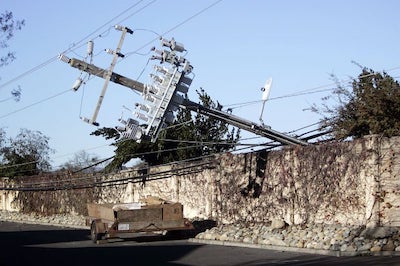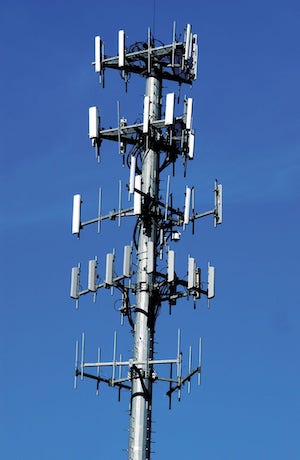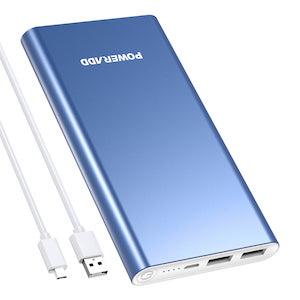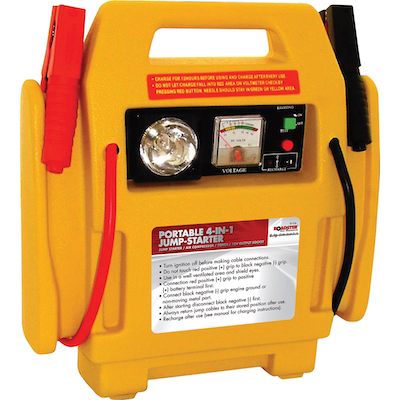 A recent 24-hour power outage at my home brought the subject of emergency preparedness to mind. Power, telephone, cable television, and fiber optic lines all had been ripped off the telephone poles by falling trees in several different locations around town during a major wind storm. Not only was the power off but all the telephones in my neighborhood were dead, the cable television was also dead, and Internet connectivity by cable or fiber optic also was inoperative. Despite these handicaps, I was able to maintain telephone communications and Internet connectivity all the time. While this outage only lasted a bit less than 24 hours, I could have maintained the same communications for a week or more without power (which I had to do after a major hurricane a few years ago).
A recent 24-hour power outage at my home brought the subject of emergency preparedness to mind. Power, telephone, cable television, and fiber optic lines all had been ripped off the telephone poles by falling trees in several different locations around town during a major wind storm. Not only was the power off but all the telephones in my neighborhood were dead, the cable television was also dead, and Internet connectivity by cable or fiber optic also was inoperative. Despite these handicaps, I was able to maintain telephone communications and Internet connectivity all the time. While this outage only lasted a bit less than 24 hours, I could have maintained the same communications for a week or more without power (which I had to do after a major hurricane a few years ago).
I moved to sunny Florida a few years ago so I no longer worry about snowstorms, ice storms, and similar calamities. However, all that has been replaced with the occasional hurricane. The details have changed but the number of power outages per year remains about the same. Each passing hurricane causes power outages of a few hours up to perhaps a few weeks. Life with the ability to cook food and without the capability of communicating (when the telephone lines are down) is not only inconvenient; it can even be life-threatening.
I would suggest everyone should think of their own preparedness for power outages, whether caused by weather, automobiles running into telephone poles, or any other calamities.
It is easy to find solutions for emergency lighting, flashlights, and even portable camping stoves to cook canned food. However, making sure your high-tech devices are ready requires a bit of planning, too.
During the most recent power outage in my neighborhood, the standard wired telephones supplied by the local telephone company all were dead simply because fallen trees and telephone poles ripped the wires off the poles. However, cellular service continued to work perfectly.
 My experience over many years of storms, downed telephone and power lines, two tornadoes, and a few hurricanes have shown that cellular telephone service is always more reliable than standard wired telephone service provided by the local telephone company. Cell towers normally have emergency diesel generators that start automatically when commercial power fails. The same generators usually have enough fuel to keep them running for several days. The towers are also interconnected by microwave or other connections that do not rely on wires that get disconnected by falling tree limbs, floods, or other hazards that can kill standard telephone service. In contrast, old-fashioned telephones have fragile wires strung on poles that are easily damaged by wind and falling trees or tree limbs. Underground utility wires work much better, but even the underground wires eventually go above ground someplace.
My experience over many years of storms, downed telephone and power lines, two tornadoes, and a few hurricanes have shown that cellular telephone service is always more reliable than standard wired telephone service provided by the local telephone company. Cell towers normally have emergency diesel generators that start automatically when commercial power fails. The same generators usually have enough fuel to keep them running for several days. The towers are also interconnected by microwave or other connections that do not rely on wires that get disconnected by falling tree limbs, floods, or other hazards that can kill standard telephone service. In contrast, old-fashioned telephones have fragile wires strung on poles that are easily damaged by wind and falling trees or tree limbs. Underground utility wires work much better, but even the underground wires eventually go above ground someplace.
Cellular telephones have proven to be reliable for years. While I have only been using cellular data service for 20+ years, the data service has been equally reliable during that time.
(I did read that some cell tower generators ran out of fuel after several days following Hurricane Katrina. The fuel delivery trucks were not able to get through the flood waters for a week or more. Of course, traditional telephone lines had been inoperative during the entire time, even the first few days when cell phones were still working perfectly. In all cases, the cell phones still worked better and longer than traditional telephones, even if they were not perfect.)
While the cell towers may remain fully operational, the weak points of individual cell phones and of personal wi-fi hotspots are batteries. Most cell phones must be recharged every 24 to 36 hours. Today's personal wi-fi hotspots that provide Internet connectivity often have an even shorter operational time. They usually need to be recharged after 4 to 6 hours of use. That certainly is not long enough to handle all emergencies. The recent power outage at my home lasted almost 24 hours, but past power outages have lasted 48 to 72 hours. I have also read about hurricanes and other widespread disasters that produced power outages of a week or longer. How do we prepare for those outages?
Two answers: generators and previously-charged batteries.
Generators
Power generators are a great solution but are expensive, bulky, and noisy for home use. Keeping a typical gasoline or diesel powered generator prepared for immediate use at any time also requires a bit of planned maintenance every few months. If you have the space and the finances for a generator, I'd say, "Go for it." However, for many people living in condos, apartments, or even in heavily populated neighborhoods, generators are not an option.
Batteries
I depend on batteries—primarily on batteries that can charge other batteries, such as cell phones, tablet computers, lanterns, and even a laptop computer. The batteries tend to be inexpensive or moderately inexpensive, never as expensive as a generator. Batteries typically require no maintenance at all other than making sure they are charged periodically and ready on a moment's notice.
 Keeping a spare external battery or two for a cell phone or tablet computer is simple and not very expensive. Dozens of companies sell external batteries that will recharge a cell phone or tablet computer. These things are simple to use: keep them charged by using whatever charger is included with the battery or with the USB connector on your computer. When needed, take the charging cable that came with your cell phone or tablet, connect one end to the cell phone or tablet in the normal manner, and connect the other end to the USB connector that is built into the external battery. Wait a few hours for the charging to complete, and your cell phone or tablet is fully charged again.
Keeping a spare external battery or two for a cell phone or tablet computer is simple and not very expensive. Dozens of companies sell external batteries that will recharge a cell phone or tablet computer. These things are simple to use: keep them charged by using whatever charger is included with the battery or with the USB connector on your computer. When needed, take the charging cable that came with your cell phone or tablet, connect one end to the cell phone or tablet in the normal manner, and connect the other end to the USB connector that is built into the external battery. Wait a few hours for the charging to complete, and your cell phone or tablet is fully charged again.
 Even gasoline-powered generators are now being replaced with battery “generators.” For one example, see the Jackery line of battery banks and solar chargers at https://www.jackery.com/. With some careful planning, these devices can supply power to your home for a week or more. (When I purchased my new Florida home I also purchased a Jackery Explorer 1000 Portable Power Station that will run my entire home (except air conditioning) for quite a few hours. With the solar charger capability, it can supply power much, much longer than a week or even more. Jackery certainly is not the only company in the business; it simply is one of the better-known brands and has many models available. It serves as an example of what is available You can find many more manufacturers of battery and solar power.
Even gasoline-powered generators are now being replaced with battery “generators.” For one example, see the Jackery line of battery banks and solar chargers at https://www.jackery.com/. With some careful planning, these devices can supply power to your home for a week or more. (When I purchased my new Florida home I also purchased a Jackery Explorer 1000 Portable Power Station that will run my entire home (except air conditioning) for quite a few hours. With the solar charger capability, it can supply power much, much longer than a week or even more. Jackery certainly is not the only company in the business; it simply is one of the better-known brands and has many models available. It serves as an example of what is available You can find many more manufacturers of battery and solar power.
Of course, batteries and solar power are silent. That is a big advantage for those who live in apartments as well as for anyone who might want to use the emergency power at night!
Prices tend to be expensive but are dropping every year. Prices for simple external batteries seem to vary from $10 to $100 or more. Units like the Jackery device can cost $1,000 or much more. Of course, gas generators are almost that expensive. The cheaper batteries will recharge a typical cell phone once while the more expensive ones have higher capacities, meaning they can recharge a cell phone five times or more before requiring a recharge of the external battery itself. You certainly will prefer that higher capacity external in a week-long power outage!
I always keep more than one high capacity external battery fully charged so that I can be prepared for a power outage of several days or even longer. These same batteries are nice to throw into a briefcase or backpack when making a long trip, such as a coast-to-coast or international trip on the airlines. Using an external battery means you can keep your tablet computer charged and operational throughout the entire flight.
I always look for external batteries with a 10,000 mAh (milli-Amp Hours) storage capacity or more. I recently purchased a 24,000 mAh external battery from an online sale. You can find these external batteries in any computer store, from Amazon, and even in some drug stores. Remember that the higher the storage capacity (measured in mAh), the more times it will recharge your cell phone during a multi-day power outage.
Some of the external batteries have a feature I like: they can be charged by built-in solar cells. The solar cells may add $10 or $20 to the purchase price but reduce the need to remember to keep them charged at all times. I keep one on the windowsill of a window facing south where it is exposed to the sun almost all day. Need a fully charged external battery in an emergency? My solar-powered battery is always ready.
Your Automobile is also a Battery Charger
One "charger" that is often overlooked is your automobile. The big battery in the car can recharge your cell phone a dozen times or more. That can keep you in communications for weeks. I always keep a charging cable for my cell phone in the automobile's glove box, along with an inexpensive adapter that plugs into the power outlet in the dashboard. These serve two purposes. First, if the cell phone battery is dead when I am driving and I need to make a call, the cable and adapter can be plugged into the power outlet and into the cell phone at any time. I then can make a call within seconds, something that is useful in emergencies. Second, if there is a power outage at the house, I can take the cell phone or tablet to the automobile and use it there, even recharge it there multiple times.
NOTE: Some automobiles only supply power to the dashboard's power outlet when the ignition key is turned on. Check yours in advance! If you want to charge your cell phone in such an automobile, you might want to invest in "power clips" that clip directly onto the automobile's battery under the hood. Any auto supply store will have these, as will Amazon and dozens of other retailers.
The Ultimate External Battery
Would you like to have the ultimate external battery that will keep your cell phone and tablet computer running for weeks? How about running a television set for several days? It will keep a power-hungry appliance operational for a few hours although not for days.
The same device can not only charge batteries, but it can also jump start dead batteries in automobiles, add air to the auto's tires, blow up beach balls, and more. Most of these external batteries also are great emergency flashlights or lanterns.
 All auto supply stores sell portable jump starters. These heavy devices always include a heavy-duty battery, capable of jump starting an automobile with a dead battery. Many of the same "jump starters" also include air compressors, lights, 12-volt power outlets, and (my favorite) even have USB connectors into which you can plug the charging cord of a cell phone or tablet. Any of these jump starters can keep your cell phone or tablet computer running for weeks.
All auto supply stores sell portable jump starters. These heavy devices always include a heavy-duty battery, capable of jump starting an automobile with a dead battery. Many of the same "jump starters" also include air compressors, lights, 12-volt power outlets, and (my favorite) even have USB connectors into which you can plug the charging cord of a cell phone or tablet. Any of these jump starters can keep your cell phone or tablet computer running for weeks.
A few jump starters—but not all of them—also include inverters that convert the internal battery's 12-volt D.C. current into 110-volts A.C. These will power a laptop computer for many hours or even a television or possibly a kitchen appliance for a few hours. Don't try to power a device that consumes a lot of power, however. No hair dryers, curling irons, or space heaters as these will run even the biggest battery flat in a short time. I doubt if you will run the air conditioning for very long even with the biggest battery!
Prices for the multi-purpose jump starters run from perhaps $40 up to $200 or so. The most expensive ones seem to appeal to professional mechanics. I probably wouldn't pay more than $125 or so. In fact, I paid exactly $125 a few years ago for a heavy-duty “jump starter” with a powerful internal battery and have used it several times since then.
Make sure the unit you buy has a "trickle charger" that you can leave plugged in all the time. Not all jump starters offer this. Leaving the battery charger connected all the time can "cook" (ruin) the battery in a jump starter that is not designed to be connected all the time. The better jump starters will include trickle chargers that can be left plugged in all the time.
Of course, these multi-purpose jump starters have many more uses than simply starting automobiles. I always keep a plugged-in jump starter in my garage and often use it to jump start a neighbor's automobile or to inflate flat tires for the same neighbors. It is always ready to power my cell phone, laptop, and tablet computers for a week or more. Of course, it also remains charged and available for any power outage at any time.
Be careful: these jump starters are heavy! That's because they have a heavy-duty battery that can keep your cell phone running for weeks.
Summation
In order to be prepared for power outages, you have multiple options to choose from. One person's best choice might not be appropriate for another person, depending upon requirements, locations, and local weather patterns. Apartment and condo owners have different requirements from those of homeowners. However, I hope this article provides fodder for your thought processes to help you decide what is best for you.
The time to plan ahead is NOW, before the snow flies and before hurricane season arrives.